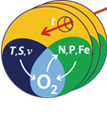SUBPROJECT - B2
Influence of the oxygen minimum zone on key nutrient stoichiometry and source/sink mechanisms in the Peru upwelling zone
Deoxygenation in eastern boundary upwelling systems (EBUS) is expected to greatly impact nutrient pools and fluxes by increasing nitrogen loss via denitrification and anammox and by increasing phosphorus and iron supply via release from sediments. These changes are expected to strongly impact the structure and functioning of pelagic ecosystems in these areas. Ship-based mesocosm studies and surveys conducted in EBUS and process models developed during SFB 754 phases 1 and 2 revealed unexpected biological responses to changes in nutrient stoichiometry and raised hypotheses concerning the underlying mechanisms. To verify these responses and test the hypotheses in a comprehensive ecosystem-biogeochemical approach we propose to (i) conduct a large-scale in situ mesocosm experiment (in collaboration with A5, B4, B5, B8, and B10) in which we will simulate upwelling of source waters with different O2/nutrient signatures in a factorial design, (ii) participate in a cruise to the Peru upwelling zone (jointly with B4, B8, B9 and B10) measuring nitrogen fixation and relating this to the ecosystem and biogeochemical characteristics of the source waters, and (iii) adapt and apply an optimality-based process model to analyse the results of the mesocosm experiments in 1D and integrate them into the 3D modelling work of subproject B1.
We are currently developing a local (1D) optimality-based plankton ecosystem model (OPEM), spanning the surface ocean down to the sediment surface (in collaboration with B1 and B6). The OPEM already includes N2 fixation and bacterial dynamics will be extended to cover anoxia-specific processes. Particle-flux rate and stoichiometry determinations provide crucial constraints for the 1D modelling work. A new hypothesis of preferential bacterial dissolved inorganic phosphorous (DIP) utilisation as a potential explanation for the dissolved organic phosphorus (DOP) accumulation observed in the mesocosms of the second SFB 754 phase will be formalised and included in the OPEM. Preliminary OPEM simulations will be used to outline the range of expected outcomes of the in-situ mesocosm experiments, which will be used to test the new hypothesis and constrain OPEM parameters once results become available. The resulting calibrated OPEM will then be available for integration into the regional and global models developed in B1.Subproject B2 will provide a comprehensive characterisation of the dynamics of the pelagic ecosystem and biogeochemical processes in the Peru upwelling zone in relation to oxygen minimum zone nutrient stoichiometries. Specifically, B2 will measure euphotic zone N2 fixation (including particle associated rates), estimate the dynamics of phosphate utilization and the fate of excess phosphorus (P*) (jointly with B5), assess the role of iron availability on the dynamics of N2 fixation and P* utilization (jointly with B10), determine rates of particle sinking and decomposition, and model interactions among ecosystem communities in different layers of the water column, mediated by sinking and remineralisation of particles, zooplankton diel vertical migration, and upwelling events (integrating information provided by B4, B5, B6, B8, and B9 and providing input into B1).
References
Franz, J.M.S., G. Krahmann, G. Lavik, P. Grasse, T. Dittmar and U. Riebesell (2012) Dynamics and stoichiometry of nutrients and phytoplankton in waters influenced by the oxygen minimum zone in the eastern tropical Pacific. Deep-Sea Res. Pt. I, 62, 20–31, doi: 10.1016/ j.dsr.2011.12.004
Franz, J.M.S., H. Hauss, U. Sommer, T. Dittmar and U. Riebesell (2012) Production, partitioning and stoichiometry of organic matter under variable nutrient supply during mesocosm experiments in the tropical Pacific and Atlantic Ocean. Biogeosciences, 9(11), 4629-4643, doi: 10.5194/bg-9-4629-2012
Pahlow, M., H. Dietze and A. Oschlies (2013) Optimality-based model of phytoplankton growth and diazotrophy. Mar. Ecol. Prog. Ser., 489, 1-16, doi: 10.3354/meps10449
Pahlow, M. and A. Oschlies (2013) Optimal allocation backs Droop’s cell-quota model. Mar. Ecol. Prog. Ser., 473, 1-5, doi: 10.3354/meps10181
Pahlow, M. and A.E.F. Prowe (2010) Model of optimal current feeding in zooplankton. Mar. Ecol. Prog. Ser., 403, 129-144, doi: 10.3354/meps08466
Pahlow, M. and A. Oschlies (2009) Chain model of phytoplankton P, N and light colimitation. Mar. Ecol. Prog. Ser., 376, 69-83, doi: 10.3354/meps07748
Riebesell, U., J. Czerny, K. von Bröckel, T. Boxhammer, J. Büdenbender, M. Deckelnick, M. Fischer, D. Hoffmann, S.A. Krug, U. Lentz, A. Ludwig, R. Muche and K.G. Schulz (2013) Technical Note: A mobile sea-going mesocosm system — new opportunities for ocean change research. Biogeosciences, 10, 1835-1847, doi: 10.5194/bg-10-1835-2013
Riebesell, U., A. Körtzinger and A. Oschlies, (2009) Sensitivities of marine carbon fluxes to ocean change. Proc. Natl. Acad. Sci. U.S.A., 106, 20602-20609, doi: 10.1073/ pnas.0813291106
Smith, S.L., A. Merico, K.W. Wirtz and M. Pahlow (2014) Leaving misleading legacies behind in plankton ecosystem modelling. J. Plankton Res., doi: 10.1093/plankt/fbu011
Wohlers-Zöllner, J., P. Breithaupt, K. Walther, K. Jürgens, U. Riebesell (2011) Temperature and nutrient stoichiometry interactively modulate organic matter cycling in a pelagic algal- bacterial community. Limnol. Oceanogr., 56, 599-610, doi: 10.4319/lo.2011.56.2.0599
Contact:
Prof. Ulf Riebesell Dr. Markus Pahlow
Tel.: +49 431 600 4444 Tel.: +49 431 600 4027
uriebesell(a)geomar.de mpahlow(a)geomar.de




